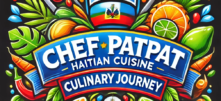Haitian Food Recipes
A Culinary Exploration
Haitian cuisine, a vibrant blend of African, French, and Spanish influences, offers a unique and flavorful culinary experience. With its rich history and diverse cultural heritage, Haitian food has evolved into a distinctive cuisine that showcases the island’s natural resources and culinary traditions.
Chef PatPat’s Insights
Chef PatPat, a renowned Haitian chef and culinary expert, has played a significant role in promoting Haitian cuisine worldwide. Her innovative recipes and passion for preserving Haitian culinary heritage have inspired countless individuals to explore and appreciate the flavors of Haiti.
Chef PatPat’s suggestions often include:
- Using fresh, local ingredients: Haitian cuisine emphasizes the use of fresh, seasonal produce, seafood, and meats. By sourcing local ingredients, you can capture the true essence of Haitian flavors.
- Experimenting with spices: Haitian cuisine is known for its bold and aromatic spices, such as chili peppers, cloves, and cinnamon. Don’t be afraid to experiment with different spice combinations to create your own unique flavor profiles.
- Preserving traditional techniques: Many Haitian recipes involve traditional cooking techniques, such as stewing, grilling, and frying. By preserving these techniques, you can maintain the authenticity of Haitian cuisine.
Frequently Asked Questions (FAQs)
- What are some popular Haitian dishes?
- Rice and beans (riz et pois): This staple dish consists of white rice and kidney beans, often seasoned with spices like bouillon cubes, thyme, and garlic.
- Griot: Deep-fried pork belly or pork shoulder, typically served with rice and beans or a side salad.
- Lambi: A popular seafood dish made with conch meat, often stewed or grilled with vegetables and spices.
- Akras: Deep-fried fritters made with black-eyed peas, flour, and spices.
- Tasso: A cured pork product that is often used in stews and soups.
- What are the main ingredients used in Haitian cuisine?
- Rice, beans, pork, beef, chicken, seafood, vegetables, fruits, spices (chili peppers, cloves, cinnamon, thyme, garlic), herbs, and oils.
- How does Haitian cuisine compare to other Caribbean cuisines?
- While Haitian cuisine shares similarities with other Caribbean cuisines, it has its own unique flavor profile and culinary traditions. Haitian cuisine often incorporates more African influences, resulting in bolder and spicier dishes.
- Are there any vegetarian or vegan options in Haitian cuisine?
- Yes, there are several vegetarian and vegan options available in Haitian cuisine. Many Haitian dishes can be adapted to accommodate dietary restrictions by substituting meat with plant-based proteins.
Pros and Cons of Haitian Cuisine
Pros:
- Flavorful and diverse: Haitian cuisine offers a wide range of flavors and textures, from spicy and savory to sweet and refreshing.
- Healthy and nutritious: Many Haitian dishes are made with fresh, local ingredients, providing essential nutrients and vitamins.
- Cultural significance: Haitian cuisine is deeply rooted in the island’s cultural heritage, offering a glimpse into the history and traditions of Haiti.
- Easy to prepare: Many Haitian dishes are relatively easy to prepare, making them accessible to home cooks of all levels.
Cons:
- Limited availability of ingredients: Some ingredients used in Haitian cuisine may be difficult to find outside of Haiti or specialized markets.
- Spicy nature: Haitian cuisine can be quite spicy, which may not suit everyone’s taste preferences.
- Lack of recognition: Haitian cuisine is still relatively unknown compared to other Caribbean cuisines, limiting its availability in restaurants and culinary publications.
Additional Insights
- Haitian cuisine and its cultural significance: Haitian cuisine is more than just food; it’s a reflection of the island’s history, culture, and identity. By exploring Haitian recipes, you can connect with the people and traditions of Haiti.
- The role of festivals and celebrations in Haitian cuisine: Haitian cuisine plays a central role in festivals and celebrations, bringing people together to share food and culture.
- Haitian cuisine and its influence on other Caribbean cuisines: Haitian cuisine has influenced other Caribbean cuisines, contributing to the region’s rich culinary diversity.
Conclusion
Haitian cuisine is a hidden gem waiting to be discovered. With its unique blend of flavors, cultural significance, and accessibility, Haitian food offers a truly unforgettable culinary experience. By exploring Haitian recipes, you can appreciate the rich diversity of Caribbean cuisine and support the preservation of Haitian culinary traditions.

